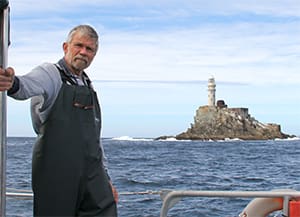Peter Smith was born in 1947 in New Zealand, and he has been a keen sailor since his kindergarten days. The result is that he’s spent the majority of his life on the water. After gaining a qualification in construction engineering, he followed his heart and co-founded and developed Cavalier Yachts in the early 70s. Cavalier produced a range of craft from 23 to 47 feet and is still popular today.
Smith racked up thousands of miles of professional ocean racing, representing himself and the company. He saw successes in events such as the Southern Cross Cup, South Pacific and World Half Ton cups, New Zealand One Ton Cup, and the Rothmans Gold Cup — New Zealand’s premier offshore points trophy — four years running.
Smith’s long-held dream, however, was to use his skills as a boatbuilder and sailor to make a living while pursuing a lifestyle of ocean cruising rather than racing. He left New Zealand in a heavily modified Cavalier 39, Apteryx, in 1979 at the tender age of 32, on what was supposed to be a circumnavigation. Instead he was broke within a year and the next eight years were spent cruising while chasing work in the West Pacific and Southeast Asia.
A contract to build an aluminum Dalu 47 for a Brunei-based client and the desire for a bigger metal boat for exploring the less-populated high latitudes saw Apteryx sold in Brunei. He moved back on land — to France, then England — saw the Dalu completed and delivered to Singapore, and followed it up with Kiwi Roa, which was launched in 1993. Smith has lived aboard ever since.
Over the years, he has amassed a range of in-depth knowledge relating to long-range cruising boat systems. As a professional boatbuilder, Smith designs, engineers and installs all of the mechanical and electrical systems and, of course, also troubleshoots and maintains these systems.
Kiwi Roa is a direct result of this lifetime of combined racing, ocean cruising and boatbuilding experience. She is a 52-foot Solent sloop/cutter built from 10-mm aluminum alloy plate (up to 25 mm in some sections), displacing 27 tonnes, built to go anywhere and handle the worst conditions. Large water, fuel and stowage capacity gives the ability to be totally independent for periods up to 18 months.
After launching in England in 1993, Kiwi Roa undertook a four-year voyage back to New Zealand via North America. It was in this period that Smith started developing his ideas of a custom anchor. Initially not a commercial exercise, a prototype for real-world use was developed in Auckland and was proven to his satisfaction during a yearlong circumnavigation of New Zealand. Interest from his friends was high, and word-of-mouth eventually made the full commercial development of the Rocna anchor inevitable by 2004.
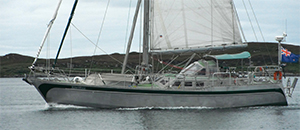 |
|
Peter Smith’s custom aluminum voyaging boat, Kiwi Roa in the Outer Scottish Hebrides. |
Smith left New Zealand again in 2008, directly south then east in a 5,500-nautical mile passage across the deep Southern Ocean to Chile, whereupon he spent three years exploring Patagonia and Tierra del Fuego, Antarctica and the South Atlantic islands of the Falklands and South Georgia.
After no fewer than seven roundings of Cape Horn, restlessness sent him east again to Cape Town. En route, the risks some voyagers take began to manifest: He suffered a 180-degree semi-roll/knockdown just south of Tristan da Cunha. Damage was minimal considering; the rig stayed in place and no water penetrated below. After six months of repairs and R&R in South Africa, he headed up the Skeleton Coast as far as Walvis Bay, Namibia, before jumping out to Saint Helena, Ascension Island and finally all the way trans-Atlantic to Newfoundland — as reported on in Ocean Navigator. Further stories still to be told involve Greenland, Europe, Morocco, Iceland, the Faroes, British Isles, Norway and Svalbard; Smith has plenty of long-range ambitions yet.
OV: What is your philosophy regarding voyaging gear? Do you like a systems-rich approach or do you prefer to keep your gear simple?
PS: The KISS principle decides all my decisions when it comes to gear and systems. However, that statement needs extensive qualification. You can ask the question: Simple by what criteria? It still has to be practical, and of adequate size. Ease of maintenance and reliability are major factors. My Cavalier 39 Apteryx would have been considered a well-equipped vessel when I left New Zealand in 1978 with the vague idea of a circumnavigation. All sails were on hanks with all halyards and main slab reefing handled at the mast. She was tiller-steered, and an Aries wind vane was essential, being short-handed. There was a CQR anchor on 10-mm chain with a Simpson Lawrence manual windlass. She had a VHF with four frequencies, a DSB HF radio with four frequency-locked crystals, a hand-held RDF and three sextants. We cooked on kerosene and had a small Blake kerosene heater on the main bulkhead.
The inclusion of a reliable refrigeration system that I built and could service myself, with the compressor run off the main engine, and a hand-cranked sewing machine set into the forepeak workbench were the only concessions to luxury.
Battery charging back then was a basic car alternator wired up to wet-cell truck batteries. It became sophisticated a few years down the track with the introduction of a rotary rheostat accessing the alternator field via a two-way switch. Output amperage was adjusted by monitoring battery voltage. Charging times were significantly reduced, although over-voltage could be equally dramatic.
Although I have moved somewhat with the times in building Kiwi Roa, the underlying principles have not changed. The windlass is now electric but well maintained and bulletproof. On launching, I carried seven old-generation anchors of various types, including the primary Delta. Now, after getting into the anchor business myself, three Rocna models are more than adequate: the 121-pound primary plus a spare, and an 88-pound on the stern.
The 120 percent genoa and Solent stay 100 percent yankee (or No. 1 jib) are on beefy rollers with the working staysail remaining on hanks (for those counting, that’s three headstays). The mainsail slab reefing and all halyards and controls are at the mast. We still cook on kerosene — a three-burner gimballed top with a fixed oven — and we carry enough kerosene in a tank to last 24 months. The rarely used heater is large diesel drip-feed. The heater and the boat’s engines can run on kerosene, as will the stove run on diesel if needed.
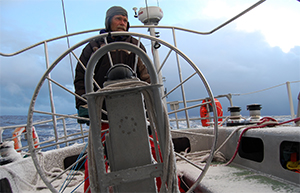 |
|
Smith at Kiwi Roa’s helm while crossing the Drake Passage. |
Electronics are basic and no electrical masthead or wind gear is carried. Gribs or weatherfax and text-only email are via SSB HF radio and SailMail. I have a basic chartplotter and 4-kW radar at the nav station, but I still carry my main sextant and tables. I have AIS and Navtex, an electromagnetic log and an old Seafarer depth finder in the cockpit, plus a second independent depth finder back at the nav station. Every system is stand-alone.
Battery charging systems are interesting in that now we have smart three-step regulators doing the job of the rheostat automatically, and batteries such as AGMs that are sealed and maintenance-free deep-cycle with faster charging characteristics. I still have a manual rheostat system in place on my panel for all three alternators if needed, however. For example, I can use the rheostat for soft-starting the 200-amp alternator if the batteries are below 50 percent. With depleted batteries, the three-step regulator demands 180 amps at the start for the first few minutes, which stresses the double belts and almost stops 8 hp at full revs. Flicking over to manual and dialing in 50 or so amps for five minutes, and then flicking the switch back to the regulator relieves the load and ensures the system is not continually stressed. The compromise is that this requires user knowledge, monitoring and control. It is not what is commonly referred to today as “user friendly.”
I run a 12-volt DC generator system, custom built by myself, to save running the main 72-hp Cummins for 3 hp of work. This is a Yanmar 1GM without gearbox, mounted on a stand-alone anti-vibration plate. This drives the 2-hp compressor for the large deep-freezer and fridge, a 2-inch Jabsco collision pump and a simple Powerline industrial 200-amp alternator, as well as heating a 40-liter hot water cylinder. Ninety minutes per day gives us 10 gallons of hot water, refrigeration pulled down for 24 hours hold-over and full batteries.
Alternative energy systems are notoriously unreliable, still do not produce enough energy and are very susceptible to damage in extreme weather. They therefore still have no place on Kiwi Roa.
If on shore power, the compressor belts are simply switched onto a 2-kW electric motor so the refrigeration systems run as usual. The hot water comes from an electric element in the cylinder and the batteries are floated on a trace 120-amp charger/2000-watt inverter.
Shore power comes into the vessel via an old-fashioned, bulletproof, 5-kVA plate-type step-up or step-down transformer. This isolates Kiwi Roa from the dock and any electrical faults in the mains or nearby vessels, as well as stepping 110-volt systems up to 220 volts. The different frequency has not proved to be a problem.
The dinghy is a 9-footer and, when powered, only requires a 2.5-hp Mariner outboard, which is easily handled and maintained (32 years old and still going strong). With 6-inch, transom-mounted retractable wheels, it is light enough to pull up a stony beach single-handed.
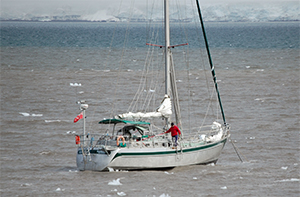 |
|
Kiwi Roa anchored at Hannah Point off Livingston Island, Antarctica. |
OV: What tools do you have on board? Are there any tools you’d consider vital?
PS: Easy question. Barring the sails and cushions and other obvious installations, I built every part of Kiwi Roa myself so I knew what tools were required to maintain her. This includes the tools and materials required to rebuild parts for pumps, drives, winches, rigging and goosenecks, etc. I carry most tools required to rebuild my particular engine except for specialist custom tools. Over the years, I have made up handy accessories to tools such as alloy pipe extension handles for items like propeller spanners that need extra torque. I can rebuild and re-gas my refrigeration system, including silver soldering, as I can my electrical systems.
Every tool becomes “vital” if you cannot fix a part without it. The secret is not to carry surplus tools. I try to be disciplined and get rid of tools I find I will never use. For example, I will never build another boat from scratch so there are many cherished woodworking tools I have slowly and sadly discarded, passing on to younger sailors.
OV: How do you decide what spares to carry? Has your mix of spares changed as you’ve voyaged?
PS: Again, spares were bought along with every item of equipment installed on Kiwi Roa when built. After 24 years of almost continuous voyaging, I have never been wanting for a part or had a system go down I cannot fix, even if only temporarily. I have learned over a lifetime what parts are required more often and what systems are more vulnerable to breakdown, and I buy in parts accordingly when the circumstances are favorable to do so — namely, postal services are reliable and import taxes are reasonable.
I always keep a running log of parts required to replace used stock. Depending on my locality, I refer to it often to remind myself what I may be looking for.
My mix of spares has been spot-on from the start. Obviously some things in the mix change with time. Items such as rigging (for the second time now) start to appear on the radar as the miles add up and things age. I am also starting to think my lifeline wires need replacing, particularly considering the long hard miles involved in a planned Northwest Passage attempt. I know where the vulnerable bits are and they still look fine, but there is that niggling doubt.
My weakness lies in electronics, such as printed circuit boards and electronic components — carrying diodes, transistors, etc., and figuring out if I can troubleshoot the problem in any way. I guess that’s why I still carry a sextant.
Again, age means some priorities have changed. I now rely much more on my autopilot, so I carry a spare motor with its electric/hydraulic pump and the MOSFET diode package it relies on. I have a reasonable chance of repairing the other parts apart from the CPU itself.
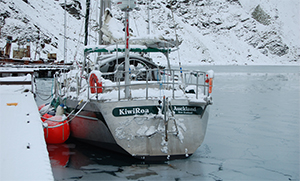 |
|
Alongside the dock in Grytviken, South Georgia Island. |
OV: Is it getting easier or more difficult to find skilled boatyard workers around the world?
PS: There are always exceptions, but in general, it is more and more difficult. Developing countries often still have skilled traditional craftsmen, but they are of very little use on the modern yacht. Diesel mechanics and metal welders are still available almost anywhere, but do they have the parts if the engine involved is not common locally? It is much harder for the bigger and more sophisticated (read: complicated) yachts to find reliable skilled tradesmen who are familiar with their equipment, particularly sails and rigs. Modern electronics, radar, autopilots and refrigeration systems are often not repairable other than in their proprietary specialist service facilities. Most brands have representatives in the bigger yachting centers around the world, but hands-on honest tradesmen who can turn their hands to anything are becoming hard to find. Never fear though: There are lots of cowboys out there eager to make a buck.
OV: What kinds of repair work do you attempt yourself?
PS: Everything, every system in the boat. Sometimes I will need to take a part to a specialist shop to have some machining done, but it’s very seldom required. I select my equipment with an eye to long-term serviceability. Sometimes it is not possible. Kiwi Roa’s Cummins engine freshwater pump also incorporates the main drive-belt idler pulley. It is built as a non-serviceable unit, although I carry a spare and if needed I should be able to keep it running long enough to find a replacement. I would most certainly try to fix the original and, in the process, devise a method of making it repairable. I would also shy away from the injector pump and a major engine rebuild, which would involve removing the engine. However, cylinder head, valves, head gasket, injectors, water pumps, etc., I do myself.
Sail repairs requiring sewing are not possible on board; although I have the skill set required, I do not carry a heavy enough industrial machine nor do I have the deck space. I can sew sun awnings, Sunbrella sail covers, etc., with the machine I do have on board.
OV: Do you use wind vane self-steering or do you rely on an electric autopilot?
PS: Both. In my younger days, all offshore sailing was done with a number of Aries wind vanes, then on a Monitor. It has been bent badly in a roll, bent by a dredger in a marina, bent by big seas while on a Series drogue over the Grand Banks and the bearings worn out and replaced three times now.
I have become lazy, I guess; running a biggish boat on wind vane can be hard work, and I tend to use the autopilot a lot more nowadays. I can drive the boat harder, as sail balance is not as critical as with the wind vane. In the high latitudes, no wind is more common than not, so motorsailing with the pilot is more the norm. If on the wind vane and I have to go forward in heavy weather, and always at night, I switch to the pilot. It is much more reliable and less likely to put me over the side. In areas where navigation can be difficult, such as the high latitudes with their poor charting, fog and ice, the pilot steers exactly where I tell it. I can watch ahead myself, check course on the plotter and adjust course as needed with the remote or at the companionway station where I have shelter, some warmth and still good visibility through the hard dodger windows. For me the pilot is worth two average crew and allows me to sail Kiwi Roa safely with only my partner and myself on board.
OV: Is your boat equipped with a watermaker? What are your reasons for having one/not having one?
PS: No watermaker. One of the most problematic systems just waiting for a disaster I have seen on the modern yacht. Environmentally a disaster, power hungry, constructed of vulnerable parts requiring continuous maintenance. The water used should be relatively clean, which is impossible in most modern harbors. To leave them unused for any period of time requires decommissioning and pickling, and vice versa on start-up again. They necessitate vulnerable filters and more through-hulls and valves. They require a watchful eye for electrolysis, which you often cannot see until the nipple breaks off, and so it goes. I can see no positive point. To make it worse, production boatbuilders are using them to justify making their boats lighter and therefore even cheaper again. It is ridiculous to make a 40-foot so-called ocean cruiser with 150 liters of water tankage. The owner has to fit a watermaker as an extra. Are modern sailors going to start doing 20-plus-day ocean crossings with six crew on 150 liters, relying on a very unreliable bit of kit and the ships’ power systems to keep them alive?
If you want to save some weight, you can control how much water you put in the tanks, but to not have that option and to have to rely on a watermaker, it beggars belief.
Kiwi Roa is designed to be self-sufficient for very long periods, and so it carries 1200 liters in two water tanks. We balance the trim by using each tank accordingly. Tank use is monitored by dipstick; it’s accurate and not misleading. No gauges.
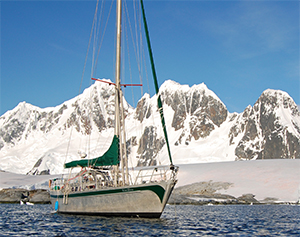 |
|
Smith and Kiwi Roa at Hovgaard Island, Antarctica. |
The decks were designed and built from scratch as water catchments. Deck drains run internally through valves to direct the flow to the tanks when the decks are clean. It is easy to clean with saltwater pressure wash or bucket, then the first five minutes of rain rinses, before turning the valves. The cockpit is a “dirty” area so it is excluded. We do not catch water that could have man-made pollution, meaning acid rain. We are always looking for rain coming off a big ocean. An advantage of internal drains is that we don’t get acid-rain pollution stains on the topsides.
In a heavy tropical-type shower, we can take 1,200 liters in 30 minutes — faster than town supply with a hose. More typical is to leave the tanks open all night in sporadic showers.
If we are in dry desert-type climates with no rain, we can go up to six months on 1,200 liters using various methods of conserving water, such as using salt water for everything but the final rinse, some cooking using a percentage of salt water, sponge bathing, etc. However, going to these extremes is rarely needed. There is usually a tap ashore close to the beach or dock. We carry five 20-liter jerry jugs in the dinghy; every trip ashore in daily life comes back with full cans. It’s easy to keep ahead and good exercise anyway. In a lifetime of cruising, I have never wanted for water.
OV: Do you rely exclusively on electronic charts or paper charts, or do you use both?
PS: I am using a plotter with an 8- or 10-inch screen, so electronic charts for “micro” and daysailing. The laptop has OpenCPN’s CM93 world charts as a backup for route planning and waypoint entry on the plotter. An Android tablet has recently been acquired and has proved handy at the helm for close-in maneuvering in tricky areas using the iSailor app with Transas charts. These have proved up to date and offer a second opinion over my Navionics Gold.
I then carry as a minimum a large-scale paper chart of any area I am sailing, enough to get in close enough to safely eyeball the last bit. It is also much easier to route plan, visualize and get oriented with a large overview paper chart.
With all the electronics in the world, I would still log position and miles every four hours or so as well. I log the 24-hourly position on the chart. It gives a starting point if the electronics go down, and with a sextant a noon latitude can always be determined to run down a westing or easting.
OV: To what extent do you use smartphones and tablets on board?
PS: As much as I hate them, smartphones are becoming compulsory in today’s world. Being a fulltime live-aboard vessel, a smartphone makes a handy Wi-Fi modem when we have mobile Internet access. The GPS function of a smartphone makes a good emergency position finder, particularly when hiking ashore or in strange foreign cities. I do not see it as a sailing navigation tool, although I know people do use them as such. The tablet makes a handy independent backup tool and my partner likes it if we have to walk to a Wi-Fi hotspot somewhere in the harbor, as is often the case. Otherwise, we both prefer our Windows laptops.

